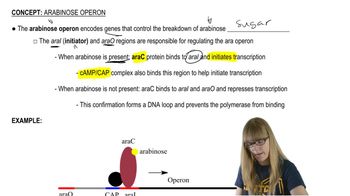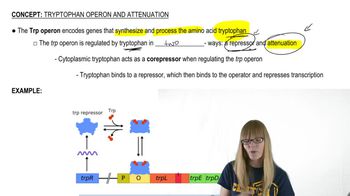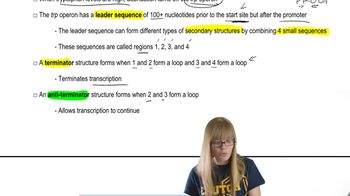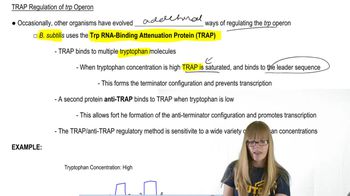Table of contents
- 1. Introduction to Genetics51m
- 2. Mendel's Laws of Inheritance3h 37m
- 3. Extensions to Mendelian Inheritance2h 41m
- 4. Genetic Mapping and Linkage2h 28m
- 5. Genetics of Bacteria and Viruses1h 21m
- 6. Chromosomal Variation1h 48m
- 7. DNA and Chromosome Structure56m
- 8. DNA Replication1h 10m
- 9. Mitosis and Meiosis1h 34m
- 10. Transcription1h 0m
- 11. Translation58m
- 12. Gene Regulation in Prokaryotes1h 19m
- 13. Gene Regulation in Eukaryotes44m
- 14. Genetic Control of Development44m
- 15. Genomes and Genomics1h 50m
- 16. Transposable Elements47m
- 17. Mutation, Repair, and Recombination1h 6m
- 18. Molecular Genetic Tools19m
- 19. Cancer Genetics29m
- 20. Quantitative Genetics1h 26m
- 21. Population Genetics50m
- 22. Evolutionary Genetics29m
12. Gene Regulation in Prokaryotes
Tryptophan Operon and Attenuation
Problem 4a
Textbook Question
Identify similarities and differences between an inducible operon and a repressible operon in terms of
the presence and action of allosteric regulatory molecules.
 Verified step by step guidance
Verified step by step guidance1
Understand that operons are clusters of genes under the control of a single promoter and are common in prokaryotes.
Recognize that an inducible operon is typically off and requires an inducer molecule to activate transcription. The inducer binds to a repressor protein, causing a conformational change that prevents the repressor from binding to the operator region.
Identify that a repressible operon is usually on and can be turned off when a corepressor molecule binds to a repressor protein, enabling it to bind to the operator and block transcription.
Note that both types of operons involve allosteric regulation, where the binding of a molecule at one site affects the activity at another site on the protein.
Compare the two: inducible operons are activated by the presence of a substrate (inducer), while repressible operons are deactivated by the presence of an end product (corepressor).
Recommended similar problem, with video answer:
 Verified Solution
Verified SolutionThis video solution was recommended by our tutors as helpful for the problem above
Video duration:
4mPlay a video:
Was this helpful?
Key Concepts
Here are the essential concepts you must grasp in order to answer the question correctly.
Operons
Operons are clusters of genes under the control of a single promoter, allowing for coordinated expression in prokaryotic cells. They can be classified into two main types: inducible operons, which are activated in response to specific signals, and repressible operons, which are typically active but can be inhibited by certain molecules. Understanding the basic structure and function of operons is essential for analyzing their regulatory mechanisms.
Recommended video:
Guided course

Arabinose Operon
Inducible Operons
Inducible operons, such as the lac operon, are typically off but can be turned on in the presence of an inducer, which is often a substrate that the operon helps metabolize. The inducer binds to a repressor protein, causing a conformational change that prevents the repressor from binding to the operator region, thus allowing transcription. This mechanism illustrates how cells can adapt to environmental changes by regulating gene expression.
Recommended video:
Guided course

Induced Mutations
Repressible Operons
Repressible operons, like the trp operon, are usually active and can be turned off when a specific corepressor is present. The corepressor binds to the repressor protein, enabling it to attach to the operator and block transcription. This system allows cells to conserve resources by halting the production of enzymes when the end product of a metabolic pathway is abundant, demonstrating a feedback inhibition mechanism.
Recommended video:
Guided course

Arabinose Operon






